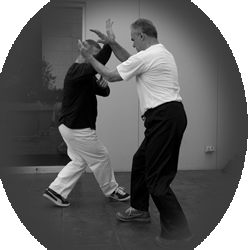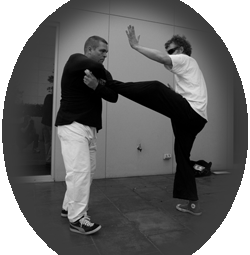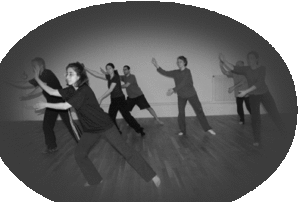What to expect when you turn up for class / training
What actually happens in class depends on who is there – the instructor adapts the teaching to the students who are present.
Tai Chi Chuan is a martial art, so training involves various types of exercise designed to enable martial competencies. It is important to remember that forms (empty hands and weapons) come from the martial techniques, so we practice the techniques first, and form after.
We normally start with 7 star step pushing hands – a simple two person exercise that teaches basic footwork and co-ordination. Other pushing hands exercises follow – we do a lot of pushing hands in Practical Tai Chi Chuan, because it is a key part of training close combat skills. Also, it’s social and it’s fun!
 Note that traditional Tai Chi Chuan, an internal Chinese martial art, often shows echoes of other similar arts.
Note that traditional Tai Chi Chuan, an internal Chinese martial art, often shows echoes of other similar arts.
Then we get into some applications – these are mostly ways of understanding hand form. A technique such as “separate hands” might have a number of different combat applications. Typically, there is one application that is almost identical to the form, then there are a few that are not so apparent. We train form applications for hands only, but also for weapons – the latter normally for the more advanced students.
Then there is conditioning, which we might call “Jiben Gong” (basic training). There are a multitude of different conditioning exercises, and different exercises work for different purposes. For example, everyone can benefit from “standing post” type qigong (Chi Kung) exercises. However, rolls and breakfalls are normally reserved for those wishing to train for actual fighting.
 Last but not least there are forms – empty hands and weapons. These will normally take up about a third of a class, finishing on a more relaxed note. Beginners will be learning the short hand form, first “square” then “round”. In square form, we break down the movements into their component parts – like learning to write with individual letters before you learn ‘joined up’ writing (ie. round form). After short form, you get to work on a weapon (normally the sabre) and start on the long form. The long, traditional, hand form of 119 movements is divided into six sections, each of which you learn square, then round.
Last but not least there are forms – empty hands and weapons. These will normally take up about a third of a class, finishing on a more relaxed note. Beginners will be learning the short hand form, first “square” then “round”. In square form, we break down the movements into their component parts – like learning to write with individual letters before you learn ‘joined up’ writing (ie. round form). After short form, you get to work on a weapon (normally the sabre) and start on the long form. The long, traditional, hand form of 119 movements is divided into six sections, each of which you learn square, then round.